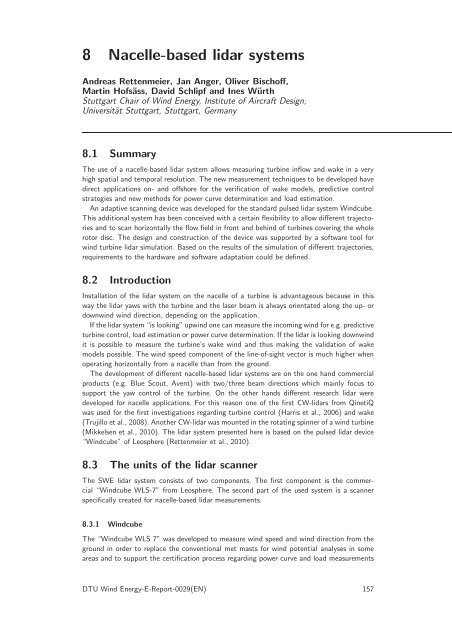Publishers version - DTU Orbit
Publishers version - DTU Orbit
Publishers version - DTU Orbit
Create successful ePaper yourself
Turn your PDF publications into a flip-book with our unique Google optimized e-Paper software.
8 Nacelle-based lidar systems<br />
Andreas Rettenmeier, Jan Anger, Oliver Bischoff,<br />
Martin Hofsäss, David Schlipf and Ines Würth<br />
Stuttgart Chair of Wind Energy, Institute of Aircraft Design,<br />
Universität Stuttgart, Stuttgart, Germany<br />
8.1 Summary<br />
The use of a nacelle-based lidar system allows measuring turbine inflow and wake in a very<br />
high spatial and temporal resolution. The new measurement techniques to be developed have<br />
direct applications on- and offshore for the verification of wake models, predictive control<br />
strategies and new methods for power curve determination and load estimation.<br />
An adaptive scanning device was developed for the standard pulsed lidar system Windcube.<br />
This additional system has been conceived with a certain flexibility to allow different trajectories<br />
and to scan horizontally the flow field in front and behind of turbines covering the whole<br />
rotor disc. The design and construction of the device was supported by a software tool for<br />
wind turbine lidar simulation. Based on the results of the simulation of different trajectories,<br />
requirements to the hardware and software adaptation could be defined.<br />
8.2 Introduction<br />
Installation of the lidar system on the nacelle of a turbine is advantageous because in this<br />
way the lidar yaws with the turbine and the laser beam is always orientated along the up- or<br />
downwind wind direction, depending on the application.<br />
Ifthelidarsystem“islooking”upwindonecanmeasuretheincomingwindfore.g.predictive<br />
turbine control, loadestimationor powercurve determination.If the lidaris lookingdownwind<br />
it is possible to measure the turbine’s wake wind and thus making the validation of wake<br />
models possible. The wind speed component of the line-of-sight vector is much higher when<br />
operating horizontally from a nacelle than from the ground.<br />
The development of different nacelle-based lidar systems are on the one hand commercial<br />
products (e.g. Blue Scout, Avent) with two/three beam directions which mainly focus to<br />
support the yaw control of the turbine. On the other hands different research lidar were<br />
developed for nacelle applications. For this reason one of the first CW-lidars from QinetiQ<br />
was used for the first investigations regarding turbine control (Harris et al., 2006) and wake<br />
(Trujilloetal., 2008).AnotherCW-lidarwasmountedin therotatingspinnerofawindturbine<br />
(Mikkelsen et al., 2010). The lidar system presented here is based on the pulsed lidar device<br />
“Windcube” of Leosphere (Rettenmeier et al., 2010).<br />
8.3 The units of the lidar scanner<br />
The SWE lidar system consists of two components. The first component is the commercial<br />
“Windcube WLS-7” from Leosphere. The second part of the used system is a scanner<br />
specifically created for nacelle-based lidar measurements.<br />
8.3.1 Windcube<br />
The “Windcube WLS 7” was developed to measure wind speed and wind direction from the<br />
ground in order to replace the conventional met masts for wind potential analyses in some<br />
areas and to support the certification process regarding power curve and load measurements<br />
<strong>DTU</strong> Wind Energy-E-Report-0029(EN) 157

















